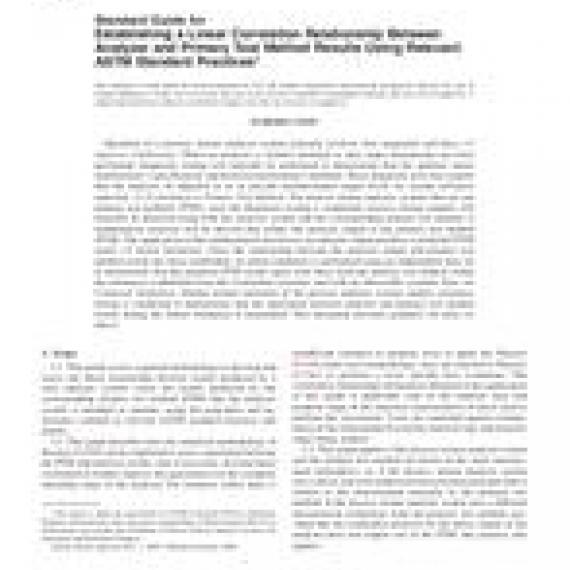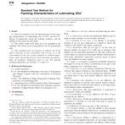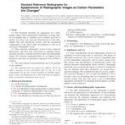No products
ASTM D7235-05
ASTM D7235-05 Standard Guide for Establishing a Linear Correlation Relationship Between Analyzer and Primary Test Method Results Using Relevant ASTM Standard Practices
standard by ASTM International, 12/01/2005
Full Description
1.1 This guide covers a general methodology to develop and assess the linear relationship between results produced by a total analyzer system versus the results produced by the corresponding primary test method (PTM) that the analyzer system is intended to emulate, using the principles and approaches outlined in relevant ASTM standard practices and guides.
1.2 This guide describes how the statistical methodology of Practice D 6708 can be employed to assess agreement between the PTM and analyzer results, and, if necessary, develop linear correlation to further improve the agreement over the complete operating range of the analyzer. For instances where there is insufficient variation in property level to apply the Practice D 6708 multi-level methodology, users are referred to Practice D 3764 to perform a level specific bias evaluation. The correlation relationship information obtained in the application of this guide is applicable only to the material type and property range of the materials representative of those used to perform the assessment. Users are cautioned against extrapolation of the relationship beyond the material type and property range being studied.
1.3 This guide applies if the process stream analyzer system and the primary test method are based on the same measurement principle(s), or, if the process stream analyzer system uses a direct and well-understood measurement principle that is similar to the measurement principle of the primary test method. If the process stream analyzer system uses a different measurement technology from the primary test method, provided that the calibration protocol for the direct output of the analyzer does not require use of the PTM, this practice also applies.
1.4 This guide does not apply if the process stream analyzer system utilizes an indirect or mathematically modeled measurement principle such as chemometric or multivariate analysis techniques where results from PTM are required for the chemometric or multivariate model development. Users should refer to Practices E 1655 and D 6122 for detailed correlation and model validation procedures for these types of analyzer systems.
Note 1For example, this guide would apply for the comparison of benzene measurements from a mid-infrared process analyzer system based on Test Method D 6277 to those obtained using PTM Test Method D 3606, a gas chromatography based test method. For each sample, the mid-infrared spectrum is converted into a single analyzer result using methodology (Test Method D 6277) that is independent of the primary test method (Test Method D 3606). However, when the same analyzer uses a multivariate model to correlate the measured mid-infrared spectrum to Test Method D 3606 reference values using the methodology of Practice E 1655, this guide does not apply. In this case, the direct output of the analyzer is the spectrum, and the conversion of this multivariate output to an analyzer result require results from the primary test method.
1.5 This guide assumes that the analyzer sampling system is fit for use, and both analyzer and lab systems are in statistical control during the execution of the required tasks. Procedures for testing for proper function of the analyzer sampling system, and ascertaining whether the systems are in statistical control are beyond the scope of this guide.
1.6 Software program CompTM Version 1.0.21 (ADJD6708) performs the necessary computations recommended by this guide.
This standard does not purport to address all of the safety concerns, if any, associated with its use. It is the responsibility of the user of this standard to establish appropriate safety and health practices and determine the applicability of regulatory limitations prior to use.


































